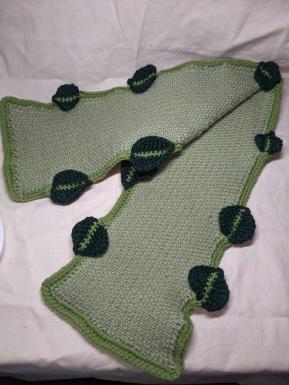Commissioning an artwork is the process of connecting a customer looking for something special with an artisan willing to make it. There are beautiful, unique things crafted by commission in every corner of the internet, but sometimes the actual process of valuing your work and negotiating the commission can be stressful. In this post, our artisans share their tips and stories for making a successful custom commission.
Find CommissionS on Our Discord
There are many places to go if you want to look for commissions. Many artisans use Instagram to find customers commissions, and there are other websites dedicated to facilitating commissions. Our favorite place to get commissions (though we are biased, we must admit) is the Looking to Commission channel on our Discord server! Head on over to that little spot and keep an eye open for co-op friendly customers looking for commissions.
How to FUlfill Commissions as an Artisan

From the perspective of an artisan, there are many steps to keep track of when opening commissions. We wanted to know more about the commission process, so we asked some artisans about their experience and found the best tips and tricks that will help you fulfill your commissions as smoothly as possible.
Before You Start
Before you start taking commissions, make sure that you have all your ducks in a row!
- Create a portfolio with previous work, including personal projects in the style you want to work in. Take photos of every piece you do – you never when this or that detail will be a helpful reference to a potential customer. Be excited about the work you want to make and other people will be excited too!
- Decide how you want to price your work. Some artists have a “menu” with their different kinds of work, but some will calculate per project. There are countless options; being prepared to have the conversation makes it go much more smoothly.
- Make sure your contact methods are easy to find and consistent. You might use a dedicated commission email, DMs on social media, or a variety of contact methods. Keep track of your inboxes and check them regularly! Schedule a time for communication in your day so you are up to date.
- Make it clear that you won’t copy other artisans’ work. Many artisans make similar work by coincidence, but there is a difference between having similar styles and directly copying someone else’s work. Make sure to use multiple references from different sources to avoid accidentally copying another artisan’s work. If a potential client is directly asking for a copycat project, that’s potentially a red flag. Never put another company’s intellectual property such as a trademark name, on your work. Depending on your craft/field/project, you may wish to politely decline, make sure the client has received permission from the original artisan (such as sharing a pattern they purchased with a commercial license), refer the client to the original artisan, or communicate with the client to make an original work that fulfills their desires. This is a complicated field, so use your best judgement and do your research!
- Before you accept a commission request, ensure that you have clearly stated your terms and that the client has agreed to them.


DragonTree Emporium’s Experience with Commissions
The commission process differs quite a bit depending on the craft. Knitter and textile artist Lizzy, from DragonTree Emporium has been taking and fulfilling commissions for 10 years. “99% of my sales are commissions”, Lizzy said. “I like commissions because they are more personal.” If she does her job well, she said, “the client gets exactly what they are looking for which is fulfilling to me”.
Lizzy’s commission process involves lots of communicating with clients. Lizzy makes custom knit and crochet pieces along with her other knit and crochet work. The first steps of a commission are painting the broad strokes: getting an idea of what the customer wants and sketching it out. The customer and Lizzy work together to choose yarns, sizes, colors, and textures, refining the idea until the customer is satisfied. Lizzy then sets out on actually making the piece, giving the customer regular updates until the project is finished. She then sends the brand new, one-of-a-kind piece to its new home!

Ask these questions!
There are lots of small places where wrinkles can appear in the commission process. Make sure that you have asked and answered these questions (and more!) with your client to ensure you are on the same page.
- Which methods of payment will you accept? Do your research on what the safest payment methods are and stick to them. If someone refuses to use a safe payment method, don’t accept the commission.
- Is the cost in the right ballpark? Many people have big ideas of what they’d like, but when confronted with the cost of the perfect thing, they will often choose the next-best thing. To save yourself time preparing quotes that never come through, try screening them with a general range of costs. A little note that says something like, “I’d be happy to make this for you, but I expect it would take at least 3-4 weeks and cost over $500. We could probably save some costs if the dimensions could be a little smaller. If that sounds okay to you, please let me know the diameter and I’ll proceed to making you a custom quote.”
- How much of the price is expected up front? Some artisans prefer payment completely up front, but others will request some of the payment at the beginning and the rest after the piece is finished. If you are commissioning a physical piece that needs to be shipped, make sure that you get paid when the piece is finished, that way you still get paid if the piece gets lost in the mail. You deserve compensation for your time, materials, and work!
- How will you handle changing the piece during the process? Many artisans send regular sketches or updates on the project, making sure that the customer gets exactly what they want. This takes a lot of time, however, and many customers will take advantage of this. Clarify how many and what kinds of changes will be allowed and at what stages of the process. This will prevent customers from exploiting your time or adding additional work that they’re not paying for.

- What will happen if the customer doesn’t like the finished product or if they cancel part-way through? If you put hours, even days, of work into a piece and the customer doesn’t pay, that is time that you could have spent on a piece that would have been paid for. Make sure to figure out a policy that works for you and your customer and stick to it! Include your cancellation and refund policies in your terms for commission.
- How much time will it take for you to finish the commission? Make sure to include time for administration and communication in your timeline. It is important to give yourself enough time to do the work well and fulfill the order while still being fast enough to make sure your customers are happy!
- What reference photos do you need? If you are unsure about what the customer wants, ask! Ask specific questions, make a mood board with the customer, do whatever will help you make the best work while still respecting your terms as an artisan!
- Do you get bad vibes from this customer? If you have any red flags, any bad vibes, any instincts about a customer or project: feel free to say no to the project! You will likely save yourself hours of potential future grief. Protect yourself and your business. Learn how to identify the difference between being nervous about a project and feeling that there is something wrong with the situation. Listen to your gut!

Walnut Studiolo’s Experience
Valerie and Geoff, who run the leather and wood working business Walnut Studiolo, have quite a portfolio of successful commissions under their belt! One project they made by commission was a custom bicycle pannier for a particular vintage Polaroid camera. As Valerie said, this project is a perfect example of “something quirky and totally one of a kind that nobody would ever, ever make in quantity.” It was made perfectly for the customer’s bike rack and vintage camera and it could only have been made custom by a skilled artisan!

An Important Note
A skill that is just as important as knowing how to fulfill a commission is knowing how to say no to a commission! There are going to be difficult customers who waste your time, requests from family members that are just too personal, people who want you to work for free, and projects that you simply don’t want to do.
An essential but difficult to learn skill is saying “no thanks”. The approach to take differs depending on the situation, but confidently and professionally declining certain commissions opens up time that you can spend better elsewhere. Not to mention that you might avoid awkward or dangerous situations! It’s difficult, but saying no is an essential skill to master if you want to successfully make commissioned work.


Conclusion
Commissions are a wonderful way to support artisans while getting beautiful, handmade, custom work. When an artisan creates a high-quality commission piece, there is more beauty and individuality in the world!
Commissioning an artist also allows them to have the time, money, and opportunity to make work outside of commission, all while enabling customers to have gorgeous, unique art! It’s a win-win situation!
It might be daunting to consider all there is to do, but researching the process and deciding on your terms will set you up for success! Now go and make beautiful things!
About Artisans Cooperative
We are growing an online handmade marketplace for an inclusive network of creatives: a co-op alternative to Etsy.
Shop the marketplace!
